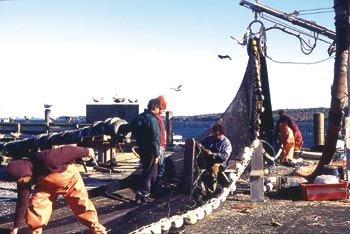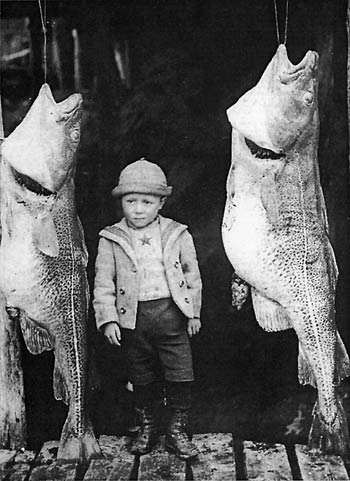One Fish — Two Fisheries
by Paul Molyneaux
|
A winch on shore wound in the thick cable that hauled the 70-foot-long sardine carrier Jacob Pike, up onto the rails in Rockland, Maine, last summer. Salt water dripped off the venerable old boat as she awaited a coat of paint. Her owner, Dana Rice, a lobster dealer from Winter Harbor and a member of the New England Fishery Management Council (NEFMC), looked over the Pike. She had survived over half a century of changes in the fishery. But the last decade, which has seen the advent of mid-water trawling, increasing bycatch problems and a steady movement toward resource privatization in the form of individual quotas (ITQs), has challenged Maine’s traditional herring harvesters more than any other.
With the crash of groundfish stocks in the early 1990’s, burgeoning herring stocks gained critical importance. Ports from Cape May, NJ, to Blacks Harbour, New Brunswick modernized their pelagic fleets and processing plants in order to tap a herring biomass that U.S. scientists claim has reached 1.8 million tons. However, herring landings have remained relatively static, at around 100,000 tons annually, with most of the fish coming from off the coast of Maine. Increasing competition for those fish has turned herring management into one of the most complex balancing acts faced by the NEFMC. As the council works on Amendment 1 to the herring fishery management plan, a growing number of interested parties have raised concerns regarding the status of the stock, ground fish and marine mammal bycatch, and the environmental impacts of mid-water trawling.
Rice watched a 108-foot mid-water trawler, the Sunlight, owned by the Rockland based O’Hara Corporation, steam across the harbor. “Here they come, must’ve been down to the rock,” he said, referring to Mount Desert Rock, twenty miles south of Mount Desert Island. “If they let these mid-water boats keep fishing in Area 1A [the nearshore waters of the Gulf of Maine from the coast out to around 50 miles] they’ll destroy this fishery, and a whole lot more.”
|

Crew of the Western Sea mending a purse seine net at McLoon’s Wharf, Rockland, Maine. Photo: Paul Molyneaux |
In the 1980’s, purse seine boats took the fishery away from the weir fishermen and stop seiners — who caught herring by running nets across the mouths of coves. A purse seine boat catches herring by surrounding the fish with a long deep net and pursing it up, creating a bag that holds the fish. The crew hauls the net in until the water boils with the bunched-up fish, at which point they pump herring aboard, or offload it onto carriers such as the Pike or the Rockland based, Double Eagle.
While seiners can only fish at night, when the herring rise off bottom, mid-water
|
trawlers have gradually taken over the fishery because they fish more aggressively: towing a net behind one boat or between two boats —pair trawlers — they can target herring anywhere in the water column, day or night. Where purse seines once dominated, mid-water trawlers now land 70 percent of the nearshore herring, and several seiners have rigged over to the new gear.
“I’ve been in it long enough to see the weirs go away, the stop seines go away, and at the rate things are going, I may see the purse seines go away,” said Rice.
continue
|
|
Bounty — The Power Of Cod
by Mike Crowe
|
The importance of fishing to the early colonial New England economy can hardly be understated, nor can the importance of cod to the industry. The Massachusetts House voted, in 1784, to place a wooden representation of a cod fish in the room where the House sits. It would be, in the words of merchant and representative John Rowe of Boston, “A memorial of the importance of the Cod-Fishery to the welfare of this Commonwealth.” The same wooden codfish still faces the speaker’s desk.
A major market for cod had long been established in Europe when colonists first arrived here. Some would say that fishermen discovered America a couple of hundred years before Columbus. During the revolution, the British sank and confiscated American fishing vessels; the fleet was devastated by the late 1780’s.
Britain had the most powerful military at the time. The typical unarmed small fishing boat was obviously no match for a 74-gun warship. While on land, the British would confront the historically familiar, human-will-meets-military monster, and a David and Goliath scenario unfolded; at sea they had the stronger hand.
Cod, John Rowe and the American Revolutionary War were factors entwined in a way that would lead to the first of the new federal government’s involvement with fishing. Rowe was a businessman and owner of a Boston wharf. When the Revolution was over, in 1789, one of the first acts of the new federal government, on July 4, 1789, was to establish a bounty on dried and pickled fish for export, to encourage fishing, boat- building and trade. The bounty, in 1789 dollars, paid 5 cents per quintal (112 lbs.) of dried fish or a barrel of pickled mackerel (200 lbs.).
continue
|
 European fishermen in the 1500’s reported the Gulf of Maine waters so thick with cod that a man could walk to shore on their backs. When they settled here cod immediately became food and revenue sources. The cod bounty was a means of using cod to rebuild the fishing fleet and sustain the fishery. Photo courtesy Provincial Archives of Newfoundland and Labrador European fishermen in the 1500’s reported the Gulf of Maine waters so thick with cod that a man could walk to shore on their backs. When they settled here cod immediately became food and revenue sources. The cod bounty was a means of using cod to rebuild the fishing fleet and sustain the fishery. Photo courtesy Provincial Archives of Newfoundland and Labrador |
|
|
   
|
|

